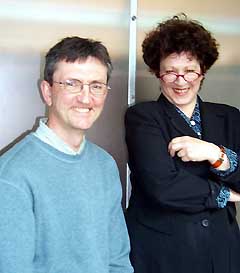
Surveys
DJC.COM
April 19, 2001
Common ground
Landscape Northwest Editor

|
Do landscape architects and architects belong in the same office? A few architecture firms in Seattle have decided that they do, and they’ve added a small staff of landscape architects in the last few years. They include Hewitt Architects, GGLO, Mithun Partners and BJSS Duarte Bryant.
“I view landscape architecture as being very integral to design,” said Dutch Duarte, president of BJSS Duarte Bryant. He and his 75-person architecture firm have been taking steps to build an in-house landscape architecture and planning group, but they have not yet found the right person to take the lead.
“Fees are really tight, and we always end up with large teams of consultants. We may be getting the best design, but we’re not getting the best service,” he said. By having the needed expertise in-house, the firm can keep the fees and schedule the work better.
All of the four firms emphasize urban design and planning in the practice of architecture — specialties in which landscape architects have played an increasing role. It’s easy to imagine the marketing advantages of one-stop design service and the economic advantages of having an in-house landscape subsidiary.
But to hear architecture principals and landscape architects who have joined them tell it, there’s much more to the story.
GGLO
Landscape architect Barbara Oakrock had a longtime Seattle practice designing community gathering places and housing sites when she joined GGLO in January of last year. Recent collaborative projects include a master plan for High Point Village for the Seattle Housing Authority, a corporate conference center, high-density mixed-use housing projects in the Denver metropolitan area, and a new town center. The 80-person firm has hired two more landscape architects in the last three months.
The firm offers full-scope landscape architecture service on some projects, for some clients, said principal Alan Grainger. However, GGLO is not trying to identify a separate profit center. “The addition of landscape architecture is very intentionally defined as an enrichment in the way to do architecture,” said Grainger.
Over the years, the firm has been dealing with larger and larger pieces of property, and there is increasing emphasis on the spaces outside the building envelope. It all comes down to the site, he said, and the open space between buildings, on the perimeter and on the top.
“The earlier we can start the analysis, the better,” he said.
“It’s an approach completely consistent with my life goals,” said Oakrock, who is trained in architecture as well as landscape architecture. “I’ve gone back to architecture school. I’m starting to learn the project types and what the controlling factors are. By being here I can come to the table with that understanding. If you come to a set of plans that you didn’t have anything to do with, it becomes tacked-on.”
This kind of collaboration is not for everyone, according to Oakrock. “It takes a certain stripe of person. Rather than dreaming of creating beautiful green spaces in the city, it’s more of a fascination with making cities by melding them with green space. By being here, the possibilities for doing that are many times greater.”
Mithun Partners
Mithun hired landscape architect Margarett Harrison three years ago and has added four more landscape architects to the staff. They have worked on the University of Washington’s Blakeley Village, Lincoln Square in Bellevue and Sunrise Senior Housing in Edmonds.
The team is now at work on Mithun’s new contract to provide design services for the city of Seattle’s Open Space Plan. There is no landscape architecture firm on the design team for the city project.
A key player on the Open Space Plan is landscape architect Deb Guenther, who joined Mithun four months ago when she moved from the Washington, D.C., office of architect HOK. After 10 years of working with landscape academic and practitioner Iain Tindell, Guenther had joined HOK to look for broader design solutions than she could find working within the traditional definition of landscape architecture, she said. Guenther clearly believes she is part of a trend.
“The whole idea of categorizing people as architects or landscape architects is something that designers are sort of moving away from,” she said.
Mithun, which was based in Bellevue until 1990 and has a long history of designing master planned communities, has worked closely with landscape architects over the years. Burt Gregory, who became president of the firm last summer, has positioned Mithun as a leader in sustainable design.
“It’s important to follow sustainable issues as they go beyond the building envelope,” said Gregory. “The integration of those elements are very important.”
And when it involves land-use entitlement, current planning work often requires landscape architecture as part of the team. “Recently, it came to principals’ attention that a number of important projects call for very immediate and spontaneous collaboration between architects and landscape architects, and that this would be easier with the landscape team sitting right in the office,” said Gregory.
The decision to hire landscape architects is also a direct response to market demand. “We found that we could offer landscape architecture services along with our projects quite easily,” he said. “We’re looking for people with good ideas,” said Gregory. “I think it sort of comes down to that.”
Hewitt Architects
Hewitt hired landscape architect Kris Snider 13 years ago to work on the redevelopment of Northeast 10th Street in Bellevue. He became a partner nine years later. Now there are five landscape architects on the 45-person staff, with two more added in the last year. They work on everything from tiny courtyards to urban streetscapes and waterfront parks. The Hewitt landscape architecture studio hires out to other architecture firms as landscape architects.
Hewitt projects include Harbor Steps East and North, Bell Street Pier, and the city of Seattle’s civic center master plan and light-rail stations.
“This kind of close proximity between architects and landscape architects is really a necessity,” said Snider. “It’s that transition between building and ground and how that is made.The firm was sensitive to that anyway. Our landscape group builds on that.”
“Landscape architects are sometimes the major drivers in architectural solutions,” said principal David Hewitt. “Many of the specialists involved in urban design are landscape architects.”
As a rule, the landscape architects at Hewitt Architects deal more with hardscapes, street edges and courtyards than with parks and trails. These kinds of projects involve close collaboration between architecture staff and landscape staff. Having landscape architects on staff allows that to happen at every stage of the project. It isn’t always easy, especially at first. “There’s a lot of nuance to the profession of landscape architecture,” he said.
A skeptic
From his position as principal of a 35-person, 30-year-old landscape architecture firm, landscape architect Jeff Girvin of the Berger Partnership is skeptical about cross-professional career benefits. Berger has lost five professional staff members in the last three years to architecture firms. All of these firms only recently begun adding landscape architects to their staffs, said Girvin.
From where he stands, there are some important differences been collaborating with architecture firms as part of a design team and joining their staffs.
“I suspect it has a lot to do with profit and control,” said Girvin. “Architects are finding that, because of the complexity of their projects, they are having to give away a lot of their fees to subconsultants.
“With the increasing compression of schedules that occurred during the last decade, architecture firms experienced a lot of scheduling and coordination issues,” he added.
“It’s going to be interesting to see if these landscape departments hang on. I think they can as long as they don’t have to be marketed as a separate entity,” he said. “Then you loose the economic edge.
“Landscape architects’ fees are rising due to the complexity and sophistication of our projects,” said Girvin. “There’s a huge spectrum of opportunities dealing with site work.”
Also, said Girvin, environmental and permitting expertise bring special value to a design team. With the Green Building Council’s LEED (Leadership in Energy and Environmental Design) rating system in place, even projects outside the city of Seattle are requiring input from landscape architects.
“Architecture and landscape architecture mesh beautifully,” said Girvin. “That’s something this firm has always believed.”
And Girvin knows what is it like to work within a firm in which other disciplines get top billing. At one time, he worked for a large engineering and planning firm. “We felt that it was a great opportunity to open the minds of (engineers). I’m sure that’s the way it works for landscape architects in architecture firms.
“There are limitations as to what types of jobs you can be involved in (as a part of an architecture or engineering firm,” he said. “If you’re an independent firm, you have the whole world out there. We have the flexibility to align ourselves with different design teams, and flexibility in how to approach a project.”
Although principals have occasionally considered adding a civil engineer, Berger will stay a landscape architecture firm, said Girvin. “We enjoy the independence that we have.”
The comments of Snider, Oakrock and Guenther point to collaborations that balance the practices of architecture and landscape architecture, as opposed to retaining the landscape architect as a kind of inside subconsultant.
“We get a synthesis of approach that we don’t get by calling (landscape architects) in later. The outcome you get from a very fluid collaboration is very different,” said Oakrock. She admitted, however, that “Architects are not terribly suggestible about this. It’s sort of left brain, right brain. It’s not until you get going through this process that the (individual) conversion takes place ... then it doesn’t take long. It’s addictive.”
Architects and landscape architects share a common language as shapers of the built environment. But they are also burdened with a legacy of professional relationships. Architects are traditionally primary consultants on design teams and higher in a professional pecking order marked by monetary compensation and prestige.
Can landscape architects keep their unique professional perspective on the staff of an architecture firm?
“That constant conversation that is out there,” said Guenther. “You just have to plug away at doing the best work you can get to. Responding effectively is going to increase your value as a part of a group.”
Clair Enlow can be reached by e-mail at clair@clairenlow.com.
Other Stories:
- Seattle adapts to life at the top
- Shedding light on the watershed
- Going digital
- New views of sustainable site design from Rainier Vista
- Giving street trees a better chance
- New rules may kill off pesticide use
- Seattle Chinese Garden: a people place
- LEED and the landscape architect
- Private projects become urban environments
- Inviting nature back to the neighborhood
- New respect for the land drives highway design
- Expanding services in times of slowdown:
Thoughts on surviving and thriving with clients - Keeping history alive
- Designing for the journey
Copyright ©2009 Seattle Daily Journal and DJC.COM.
Comments? Questions? Contact us.